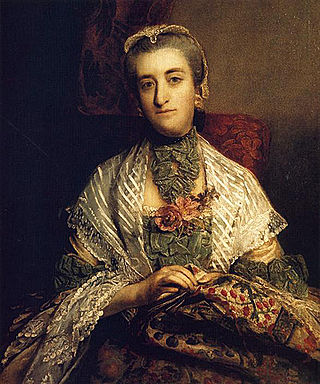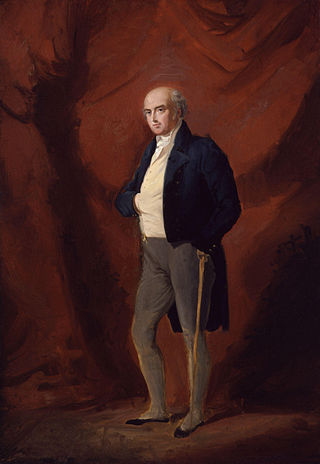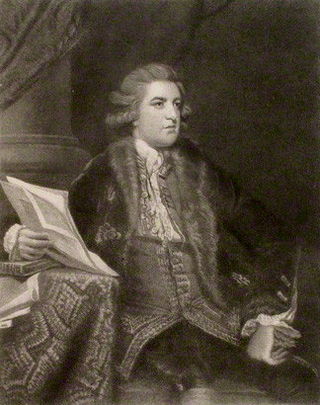
Georgiana Carolina Fox, 1st Baroness Holland, of Holland, known as Lady Caroline Lennox before 1744 and as Lady Caroline Fox from 1744 to 1762, was the eldest of the Lennox sisters.

Henry Richard Vassall-Fox, 3rd Baron Holland of Holland, and 3rd Baron Holland of Foxley PC, was an English politician and a major figure in Whig politics in the early 19th century. A grandson of Henry Fox, 1st Baron Holland, and nephew of Charles James Fox, he served as Lord Privy Seal between 1806 and 1807 in the Ministry of All the Talents headed by Lord Grenville and as Chancellor of the Duchy of Lancaster between 1830 and 1834 and again between 1835 and his death in 1840 in the Whig administrations of Lord Grey and Lord Melbourne.

Earl of Ilchester is a title in the Peerage of Great Britain. It was created in 1756 for Stephen Fox, 1st Baron Ilchester, who had previously represented Shaftesbury in Parliament. He had already been created Baron Ilchester, of Ilchester in the County of Somerset in 1741, and Baron Ilchester and Stavordale, of Redlynch, in the County of Somerset, in 1747. These titles were also in the Peerage of Great Britain. All three peerages were created with remainder, failing heirs male of his own, to his younger brother Henry Fox, who was himself created Baron Holland in 1763. The brothers were the only sons from the second marriage of the politician Sir Stephen Fox.

Lieutenant-General James FitzGerald, 1st Duke of Leinster, PC (Ire), styled Lord Offaly until 1743 and known as The Earl of Kildare between 1743 and 1761 and as The Marquess of Kildare between 1761 and 1766, was an Anglo-Irish nobleman, soldier and politician.

Henry Edward Fox, 4th Baron Holland of Holland, 4th Baron Holland of Foxley was briefly a British Whig politician and later an ambassador.

Stephen Fox, 2nd Baron Holland of Holland and 2nd Baron Holland of Foxley of Holland House in Kensington, Middlesex, was a British peer.
Giles Stephen Holland Fox-Strangways, 6th Earl of Ilchester, styled Lord Stavordale until 1905, was a British peer and philanthropist.

Henry Stephen Fox-Strangways, 3rd Earl of Ilchester, PC, styled Lord Stavordale from birth until 1802, was a British peer and Whig politician. He served as Captain of the Yeomen of the Guard under Lord Melbourne from 1835 to 1841.

Stephen Fox-Strangways, 1st Earl of Ilchester PC was a British peer and Member of Parliament.

Henry Thomas Fox-Strangways, 2nd Earl of Ilchester, known as Lord Stavordale from 1756 to 1776, was a British peer and Member of Parliament.

Henry Edward Fox-Strangways, 5th Earl of Ilchester PC, known as Henry Fox-Strangways until 1865, was a British peer and Liberal politician. He served as Captain of the Honourable Corps of Gentlemen-at-Arms under William Ewart Gladstone between January and February 1874.

John FitzPatrick, 2nd Earl of Upper Ossory FRS DL, styled Lord Gowran from 1751–8, was an Anglo-Irish peer, soldier, and member of parliament.
The Lennox sisters were four eighteenth-century British aristocrats, the daughters of Charles Lennox, 2nd Duke of Richmond (1701–1750) by his wife Lady Sarah Cadogan (1705–1751).

Little Holland House was the dower house of Holland House in the parish of Kensington, Middlesex, England. It was situated at the end of Nightingale Lane, now the back entrance to Holland Park and was demolished when Melbury Road was made. Number 14 Melbury Road marks its approximate location.

The Honourable John George Charles Fox-Strangways was a British diplomat, Whig politician, and courtier.
The Fox family is a noble family of England that held the title of Baron Holland from 7 March 1762 when it was created for Lady Caroline Fox until 18 December 1859 upon the death of Henry Fox, who died without living issue leading to the title becoming extinct. The family has held the title of Earl of Ilchester since its creation for Stephen Fox in 1756.

Holland House, originally known as Cope Castle, was an early Jacobean country house in Kensington, London, situated in a country estate that is now Holland Park. It was built in 1605 by the diplomat Sir Walter Cope. The building later passed by marriage to Henry Rich, 1st Baron Kensington, 1st Earl of Holland, and by descent through the Rich family, then became the property of the Fox family, during which time it became a noted gathering-place for Whigs in the 19th century. The house was largely destroyed by German firebombing during the Blitz in 1940 and today only the east wing and some ruins of the ground floor and south facade remain, along with various outbuildings and formal gardens. In 1949 the ruin was designated a grade I listed building and it is now owned by the Royal Borough of Kensington and Chelsea.

Mary Fox, Baroness Holland, known as Lady Mary Fox from 1766–74, was an Anglo-Irish aristocrat from the Mac Giolla Phádraig dynasty and Fox family. She is best known for being the portrait subject of several notable 18th-century artists, including Thomas Gainsborough and Sir Joshua Reynolds.

Elizabeth Fox, Countess of Ilchester (c.1723–1792), née Elizabeth Horner, was the wife of Stephen Fox-Strangways, 1st Earl of Ilchester.
















